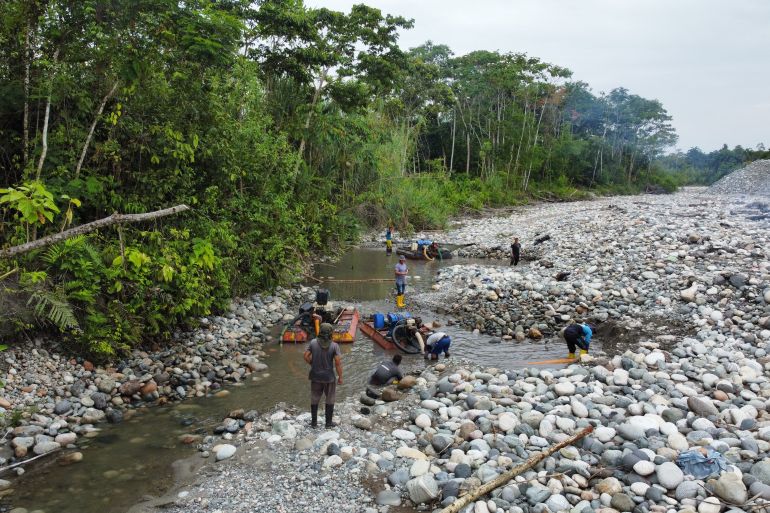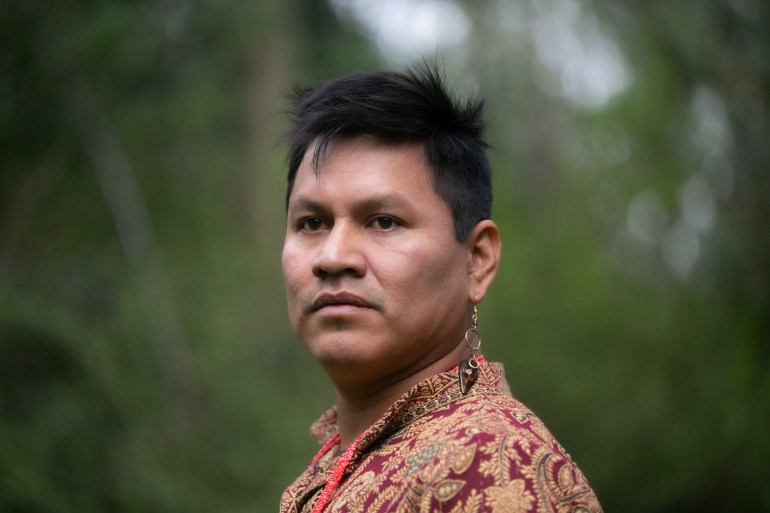Ecuador: Indigenous villages fight ‘devastating’ mining activity
Government’s failure to regulate mining has damaged the environment and human health, community members say.

Napo, Ecuador – As a child, Leo Cerda would spend his mornings helping his family cultivate cassava, plantains and other fruits and vegetables in their chakra, a traditional garden in Kichwa communities.
In the Ecuadorian village of Napo, traditions form a large part of family and spiritual life. At around 3am each morning, before heading to their chakras, many families take part in a traditional tea ceremony. Once freed from his farming duties at around midday, Cerda recalled running to the river to swim and fish with friends. Fish would later be grilled on an open fire and eaten with large amounts of fruit.
Keep reading
list of 3 itemsEcuador imprisonment ‘almost a death sentence’: Amnesty
Ecuador gov’t, Indigenous leaders reach deal to end protests
“As a kid, I got to enjoy nature,” Cerda told Al Jazeera.
These days, however, the 34-year-old spends his days chasing gold miners from his community and campaigning against those who threaten to destroy his ancestral lands. He can no longer swim or fish in the rivers, he says, because they are contaminated.
“Within three years, everything changed,” Cerda said. “The land has been poisoned. There are no more fish, except ones that are contaminated. People eat them, and they get sicker and sicker.”
A recent study carried out in mining areas of the northeastern Andean foothills of the Ecuadorian Amazon, close to where Cerda lives, revealed high concentrations of toxic metals. They are up to 352 times above permissible limits established by environmental guidelines. For communities along the Anzu, Jatunyacu and Napo rivers, their cancer risk is up to three times greater than the acceptable threshold.
Mariana Capparelli, a researcher who contributed to the study, told Al Jazeera it was “very sad to see the conditions these communities are exposed to as well as the total degradation of an ecosystem that is so important for the entire planet”.
“The effects on human health are devastating,” she said.
Toxic waste
Due to what critics say is an absence of sufficient government regulation, mining in Ecuador has led to environmental pollution and adverse effects on the health of Indigenous communities. In recent months, authorities have carried out several raids against illegal miners.
But with widespread state corruption and tip-offs given to miners, machinery is sometimes withdrawn immediately before police operations take place, activists say, highlighting the need for additional protections.
Ecuador has a national system of protected areas that aims to safeguard biodiversity and local ecosystems in national parks, wildlife refuges, marine reserves and other designated areas throughout the country. Although the government has taken some steps to protect local water systems, rivers have traditionally not been included in this system.
A Canadian researcher who has studied mining in Ecuador said toxic waste is “easily assimilated by the human body and stored in the brain and breast milk”. Speaking to Al Jazeera on the condition of anonymity for fear of repercussions, the researcher added: “It passes readily to babies and young children who are still breastfeeding and interferes with their brain development. It also passes through the placenta and enters into developing fetuses and can affect their brain development as well.”
Al Jazeera tried to reach several government officials in Ecuador’s environment and energy ministries for comment but did not receive a response by the time of publication.
According to Andres Tapia, a spokesperson for the Confederation of Indigenous Nationalities of the Ecuadorian Amazon, illegal mining has become “uncontrollable” in parts of the country. Many areas of Napo have been “invaded and taken over by illegal mining mafias”, Tapia told Al Jazeera.
Figures released by the Monitoring of the Andean Amazon Project show that areas dedicated to mining in Napo province increased from 2.6 hectares (6.4 acres) in 1996 to 556.8 hectares (1,375.9 acres) in 2020. Across three key locations – the Anzu River, Arosemena Tola and the Huambuno River – 490 hectares (1,211 acres) of land were affected from 2017 to 2022, the equivalent of 687 professional football fields.
“I thought I would always be able to drink from this river,” Eli Virkina, a member of an Indigenous Kichwa community in Napo, told Al Jazeera. “Now I’m at this point where maybe I shouldn’t even swim in the water. That is really heartbreaking for me.”
In the past few years, Virkina says she has witnessed an increasing number of large machines, black smoke and noise pollution along the river. Recently, she discovered lumps around her breasts and changes to her skin. “I haven’t felt okay for the past two years – mentally, because of what’s happening, but also physically.”

Community resistance
Across Napo, Indigenous communities and organisations have been monitoring, mobilising and resisting mining activities. To defend their land, they have formed alliances and connections across riverine communities, including the Amazon’s first women-led Indigenous guard.
In February 2022, a landmark Constitutional Court ruling recognised the rights of Indigenous communities to have a final say over extractive projects that affect their territories. The ruling “offers one of the strongest legal precedents in the world, which upholds the rights of Indigenous peoples to decide on the futures of their ancestral territories”, according to the Amazon Frontlines advocacy group.
But in December, the ruling was disregarded when the government approved a mining project in Las Naves in Bolivar province without gaining the consent of affected communities.
In the meantime, Napo has installed four alarm systems around the village to signal when miners are close by.
“In our territory, spears were not used anymore, but now we have one in at least every house because it’s part of the way we have to defend ourselves,” said Majo Andrade, a member of the female-led Indigenous guard Yuturi Warmi.
Cerda said he believes the national government must do more to protect its citizens: “It’s not able to protect resources, our lands and territories.”
At the same time, Virkina says Indigenous resistance is vital to the region’s future.
“Once [Indigenous people] disappear, it is way easier for miners and people to come in and access the river,” she said. “When we have stronger Indigenous communities, we have stronger forests and a stronger river.”